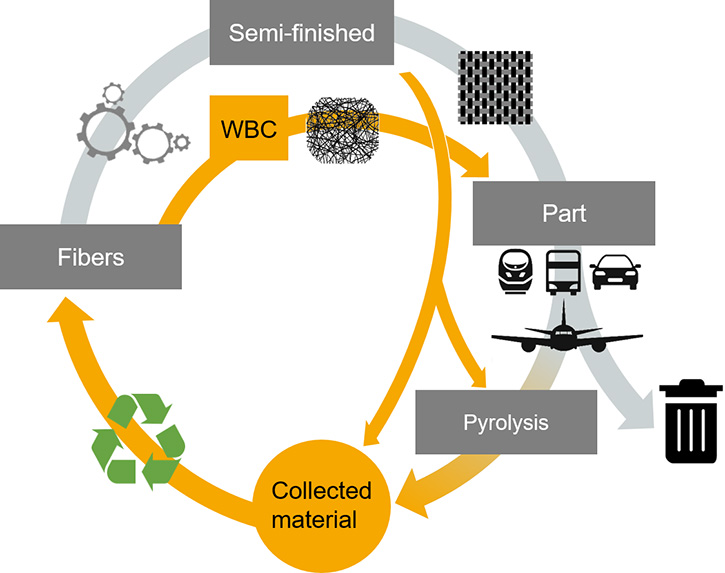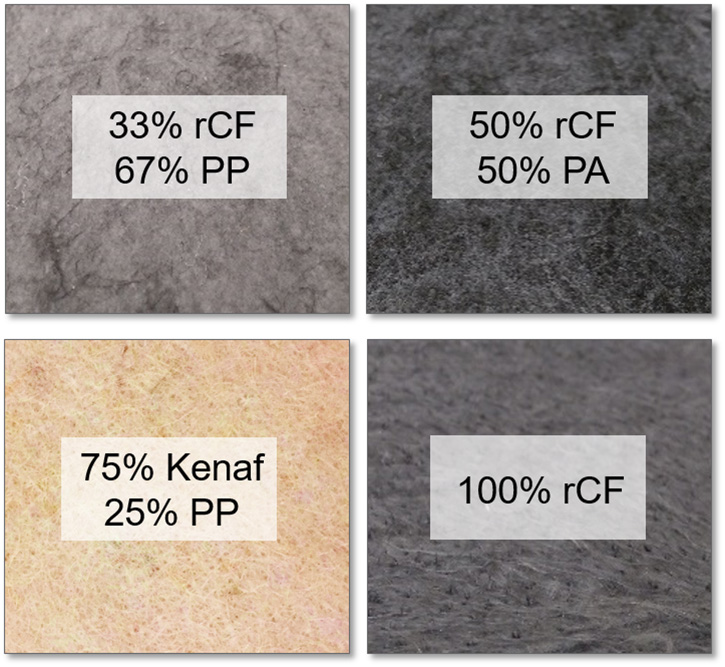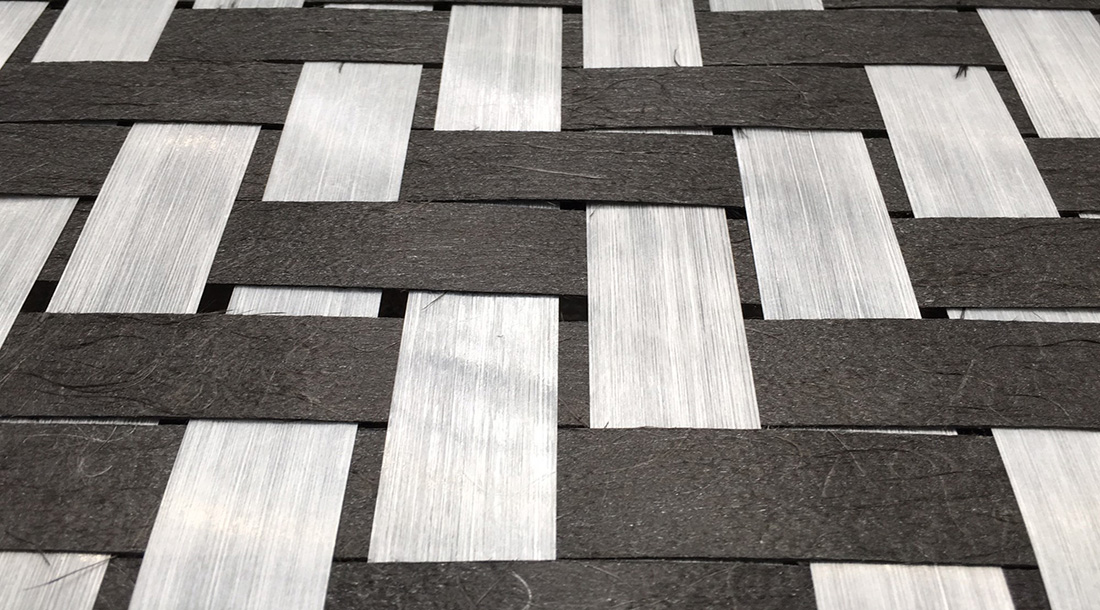Web-based composites are nonwoven-based composite materials that meet the demand for sustainability and light weight. This new class of materials offers the possibility of processing recycled composite waste and thus introducing them into a closed-loop economy. As a result, there is a need for new thermoplastic fibers with adapted property profiles.
Growth in lightweight construction
Lightweight construction is needed in various growth market sectors. These include not only the aerospace and automotive sectors, but also new segments, such as air taxis. The use of composites can result in economic and ecological advantages, such as fuel savings.
Composites can be used to address the megatrends of mass production, larger structures, cost savings and digitalization. This leads to increased demand for carbon fibers with a growth rate in the double-digit percentage range.
Carbon fiber reinforced web-based composites compete with glass fiber-based organosheets on both mechanical properties and price. However, the shorter process chain of web-based composites is a systematic advantage.
Circular economy
While the industrialization of composites is progressing steadily, one of the current challenges is the recycling of these materials. Landfill is problematic, owing to stricter legal requirements and is ecologically undesirable because the production of the fibers is energy-intensive.
The other established method of disposal is the compounding of shredded composites into injection-molded parts. Here, however, the mechanical characteristics are lost to a considerable extent.
A new and sustainable way is the use of web-based composites in which the long fiber characteristics, and thus the potential for high mechanical properties, are retained.
Manufacturing process
The starting material for web-based composites is a mixture of reinforcing fibers and thermoplastic fibers, which later form the matrix of the composite. The reinforcing fibers are usually carbon or glass fibers, which originate from dry cuttings or pyrolized fibers.
This mixture can be processed into an organoweb in the carding process – this semi-finished product forms the basis for the subsequent thermoforming process.
The combination of thermoforming and injection molding allows the fully automatic production of highly functionalized components in a very short cycle time. Other processing routes are also possible; for example, resin transfer molding (RTM) or thermoplastic resin transfer molding (T-RTM) processes with a 100% glass or carbon fiber nonwoven.

Advantages compared with organosheets
Carbon fiber reinforced web-based composites compete with glass fiber-based organosheets on both mechanical properties and price. However, the shorter process chain of web-based composites is a systematic advantage.
In contrast to organosheets, yarn formation is not necessary, which results in a leaner production chain and shorter production time, i.e., the elimination of a heating process. An example is the elimination of bobbin leftovers and a freely adjustable basis weight – without the process step of stacking. This results in lower production costs compared with organosheets. At comparable material costs, the stiffness is 70% higher and the weight reduction is almost 30%.
Property profile
The machine setting of the highly flexible carded web process allows a tailor-made property profile to be set; for example, the orientation of the fibers can be varied. This allows isotropic or anisotropic properties of the composites, which means the manufactured part can be designed to match the load path.
The structure of the organoweb can also be adjusted so that the semi-finished product has exactly the required drapability for the subsequent process (e.g., thermoforming).
The variation of fiber mixture and fiber type is particularly attractive, as the fiber mixture can be used to achieve a high fiber volume content for high-performance components. The combination of natural fibers, such as flax or hemp, with a thermoplastic fiber based on renewable resources can also be achieved for ecological components.
Suitable thermoplastic fibers
The choice of thermoplastic fiber depends on the application. The most common fibers are polyamide (PA), polypropylene (PP), polyethylene terephthalate (PET) and polymers based on renewable resources.
Owing to their low density and material costs, PP fibers are favored for automotive interiors, while PA offers better temperature behavior and suitability for the cathodic dip coating process in the car body in automotive engineering.
The use of polymers based on renewable resources is growing. Even though they are based on renewable raw materials, they are increasingly showing less variation in their properties. This group has high potential, especially due to the interest in sustainability.
The way to fiber composites
As part of current research projects, ITA Augsburg is working to find the best way to combine the thermoplastic fiber with the reinforcing fiber. The investigations range from foil or nonwoven stacking to the introduction in powder or fiber form and the in-situ method.
For example, the introduction of thermoplastic by the in-situ method in the T-RTM process shows high potential. However, the fiber application is preferable owing to its high process stability.
From a holistic point of view, the best way is to introduce the thermoplastic as fiber. Based on this knowledge, it makes sense to optimize the thermoplastic fibers specifically for this application. Previous investigations have been carried out with standard fibers; the further potential must be exploited.

Applications
Web-based composites have already proven their potential for large-scale production in several applications. For example, these new materials can be found in model series of German premium car manufacturer BMW.
Web-based composites can also be used successfully in the automated tape laying or tape weaving process. For this purpose, ITA Augsburg has developed highly oriented RecyTapes in the MAI RecyTape project, which is the basis for high-performance components made of recycled fibers. This semi-finished product can be processed in established systems without the need for conversion.
In the current CC4 CosiMo (Composites for sustainable Mobility) research project, ITA Augsburg is focusing on the industrial production of tailored nonwovens. It is pursuing this path together with leading industrial companies, such as KraussMaffei, Faurecia, KUKA and SGL. The partners remain positive about the potential of the new material class of web-based composites based on the results of this research project thus far.



